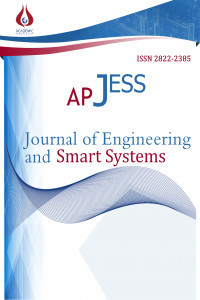Sivas 4 Eylül Barajı Su Kalitesi-Seviye İlişkisinin Coğrafi Bilgi Sistemi (CBS) İle Haritalanması
Göl ve barajlara gelen ve buradan çıkan kirletici yüklerin oluşturacağı etki, uzun bir zaman dilimi içinde ortaya çıkmaktadır. Su ortamlarında kirlenmeyi belirleyen belli başlı kriterler fizikokimyasal ve biyolojik faktörlerdir. Bir suda yaşayan canlıların biyolojik çeşitlilik, besin zinciri, su kalitesi ve suyun biyolojik yönden temizlenmesi gibi faktörler açısından büyük bir önemi vardır. Son yıllarda baraj göllerinin fiziko-kimyasal özelliklerinin incelendiği çalışmalar artış göstermiştir. Bu çalışmada; Sivas kentinin içme suyu ihtiyacının karşılandığı 4 Eylül Barajı’nın 12 farklı noktasında her 5 m’de bir numune alınmıştır. Bu numunelerde sıcaklık, EC (Elektriksel iletkenlik), çözünmüş oksijen (Ç.O), pH, bulanıklık, mangan (Mn), demir (Fe), NO3 (Nitrat) ve organik madde analizleri yapılmıştır. Bu analizler ile birlikte barajda seviyeye bağlı su kalitesi belirlenmiştir. Elde edilen analiz sonuçları, CBS’nin analiz yöntemlerinden olan Kriging enterpolasyon yöntemi ile değerlendirilmiş ve barajın farklı derinliklerindeki su kalitesine ait mekânsal dağılım haritaları oluşturulmuştur. Çalışmadan elde edilen sonuçlara göre; mangan değerinin derinlik arttıkça arttığı, Fe değerinin ise önemli bir değişiklik göstermediği belirlenmiştir. Organik madde miktarının yüzeyde çok fazla iken belli bir derinlikten sonra çok fazla değişmediği, ayrıca derinliğe bağlı olarak pH değerinin de değişim göstermediği belirlenmiştir. Ölçülen NO3 değerleri 0.1-0.3 mg/L arasında değişirken çözünmüş oksijen değerlerinde önemli bir değişiklik gözlenmemiştir. Bulanıklık gölün tabanına doğru oldukça artmıştır. EC değerinin ise derinlikle önemli bir değişim göstermediği, göl kenarlarındaki EC değerlerinin gölün orta kısmına göre daha yüksek değerlerde olduğu belirlenmiştir.
Mapping of Water Quality-Level Relation of Sivas 4 Eylül Dam With Geographic Information System (GIS)
The effect of pollutant loads coming from and coming out of lakes and dams arises over a long period of time. The main criteria that determine contamination in aquatic environments are physicochemical and biological factors. Biodiversity, nutrient chain, water quality and the cleanliness of water from the biological side are all important factors in living an aquatic life. In recent years, the studies on the physico-chemical properties of dam lakes have increased. In this study; a sample was taken every 5 m from 12 different points of the 4th September Dam where the drinking water of Sivas city is met. These samples were analyzed for temperature, EC (electrical conductivity), dissolved oxygen, pH, turbidity, manganese, iron, NO3 (nitrate) and organic matter. With these analyzes, water quality related to the level at the dam was determined. The obtained analysis results were evaluated by Kriging interpolation method which is one of the analysis methods of GIS and spatial distribution maps of water quality at different depths of the dam were created. According to the results obtained without working; It was determined that manganese value increased with increasing depth and Fe value did not show any significant change. It has been determined that the amount of organic matter does not change much after a certain depth while it is too much on the surface, and it does not change in pH value depending on the depth. The measured NO3 values ranged from 0.1 to 0.3 mg / L, but no significant change in dissolved oxygen values was observed. The turbidity has increased considerably towards the bottom of the lake. It was determined that the EC values did not show a significant change and the EC values at the edge of the lakes were higher than the middle part of the lake.
___
- Ülker Aslı GÜLER - ulkerasli@gmail.com
- Fuat ÖZYONAR - fozyonar@cumhuriyet.edu.tr
- Ahmet AYGÜN - ahmet.aygun@btu.edu.tr
